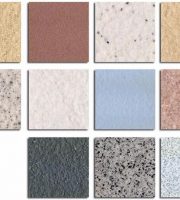Pour clean water into the clean bucket, slowly pour the putty powder into the bucket, use an electric mixer, pour and stir until there is no particle, stand still for 5 minutes, and then stir again.
4.
Phenomenon 5 there is floating ash or pulverization on the base course, resulting in blistering, generally blistering or bulging and delamination; Cause analysis: the base course is powdered or there is a large amount of floating ash, which can not be effectively bonded after applying putty, resulting in bulging or foaming; Solution in this case, it is necessary to clean the base course, remove the floating ash or remove the unstable base course before applying putty.
2.
Inferior putty powder.
The base is loose and the wall is not fixed.
3.
The solution can be solved by scraping the first time with coarse putty with low viscosity, or scraping the first time with gypsum putty that can be quickly formed without rebound.
4.
Solution 1.
The bursting and bubbling on the surface after construction for a period of time is mainly caused by uneven mixing.
When puttying, the air in the pits is compressed and the air cannot be effectively discharged.
3.
After the pressure is released, the puttying film is jacked up to form bubbles; The solution is to roll a layer of liquid interface agent or coarse powder interface agent with a roller, and then apply relatively coarse putty after drying.
The owner thinks it is the construction problem, and the construction master blames the quality problem of putty.
When scraping on such a base surface, the air hole is sealed by the putty paste, and the air in the air hole is compressed, which will form the accumulated potential energy; After being compressed by the air, the air bubbles in the putty body will rebound and form a sealing eye; Cause analysis: the mortar surface is too rough and there are many small pits.
Solution: do not break the air hole of the first layer, and continue to scrape with leveling putty or gypsum to cover the bubbles of the first layer.
Cause analysis 1.
Problem 4: low hardness of powder removal, analysis of reasons for powder removal, poor putty powder problem 5: analysis of reasons for hollowing and delamination 1.
3.
Inferior putty powder.
Carefully read the instructions of the product and mix the water according to the correct proportion.
Generally, the putty is stirred evenly, left for about 10 minutes, and then stirred again with an electric mixer and then put on the wall.
Cause analysis 1.
High grade coatings are not primed.
Inferior putty powder.
The moisture content of the base course is too high, and the density is too large or too small.
2.
We respect originality,.
So who is responsible? Here, Xiaobian will solve your doubts! Problem 1: there are particles 1, poor dispersion and pimples.
Source: the article is transferred from the Internet.
It is caused by foaming of a batch of putty and appears after grinding.
In the environment of excessively dry wall or strong wind and light, wet the wall with clean water as much as possible, and scrape the putty layer after there is no open water on the wall.
Due to the rich voids and high moisture content of the putty, it is airtight, and the air is enclosed in the void cavity, which is not easy to eliminate.
After construction, it absorbs a large amount of water and swells to form bursting.
Phenomenon 3 reasons for foaming of the second layer of putty: the first layer of putty did not eliminate bubbles.
Solution 1.
The base is too rough and the batch swing speed is too fast; 2.
For the same reason, a new bubble continued to be generated on the first air hole.
Incorrect water mixing ratio.
Batch scraping feels heavy.
After it is completely dry, apply putty products with low viscosity and strong flexibility.
Choose high quality putty.
During the priming of wall decoration, we often encounter the problem of blistering.
2.
When puttying, the air in the pits is compressed and the air cannot be effectively discharged.
2.
In case of blistering on the second or last surface course of construction, the blister shall be broken with a scraper before the watermark is eliminated to ensure that there are no bubbles on the putty surface.
If there is a large area of foamed putty surface, directly crush the small bubble mouth with a shovel, and scrape the foamed surface with appropriate putty again.
5.
The slurry contains powdery particles that cannot be dissolved in time.
Phenomenon 4: there are bubbles on the base surface of concrete ceiling, which generally have large bubbles or hollows; Cause analysis: the base course of the concrete ceiling is smooth and inconvenient for construction, and the brushing force is uneven, which leads to the failure of firm bonding of the putty layer, coupled with the gravity of the putty layer itself, resulting in blistering; Solution: it is recommended to conduct interface treatment before applying putty.
Problem 2: there are bubbles.
Problem 3: there are pinholes, pits and sand marks after grinding.
The putty layer for one-time construction is too thick, greater than 2.0mm; 3.
2.
Phenomenon 6 bubbles are generated during construction and the surface of putty bubbles after a period of time.
After the pressure is released, the puttying film is jacked up to form bubbles;.
3.
1.
2.
Incorrect mixing method.
Phenomenon: the base surface of the second batch of putty is the cast-in-situ concrete wall, and there are dense air holes on the surface after demoulding.
1.
There are bubbles on the rough mortar base, and dense and small bubbles on the putty; Cause analysis: the mortar surface is too rough and there are many small pits.
For particularly rough walls, the general primer shall be coarse putty as far as possible.
When scraping the second layer of putty, it was customary to take a shovel to level the bubbles in the first layer, which broke the bubbles in the first layer, and returned to the above two cases.



